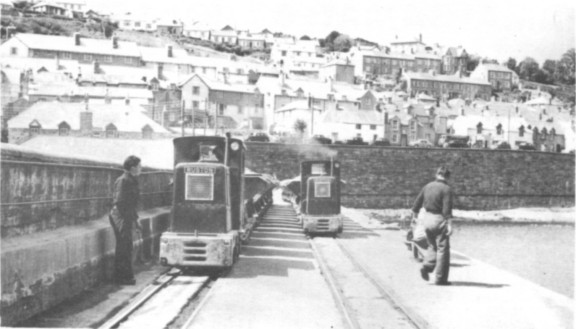
| THE INDUSTRIAL RAILWAY RECORD |
© AUGUST 1968 |
AMALGAMATED ROADSTONE
KEITH FARMER
An article on the locations where railways have been operated by the Amalgamated Roadstone Corporation was suggested after I'd acquired a copy of their official list of locomotives. The companies in the group are some of this country's largest producers of roadmaking materials. Amalgamated Roadstone Corporation Ltd was formed on 23rd April 1935 to acquire, inter alia, Carreg−y−Llam Quarries Ltd and Port Nant Quarries Ltd (both at Llithfaen, Caernarvonshire) and the Penlee Quarries in Cornwall. By 1958 some fifty-eight quarries had been acquired from various companies which in most cases did not lose their identities as they continued to trade under their old names. Most of the share capital of British Quarrying Co Ltd, formed on 4th February 1929 and the largest of the constituents, had been acquired before it went into liquidation on 31st October 1947 to complete the merger with A.R.C. of its group of companies. These had also been trading under their old titles and railway enthusiasts visiting places like Criggion at this period, where any one of three titles might have been noted, were never certain who owned what!
In the text which follows, the letters preceding the location titles are used to indicate their positions on the map, and allocations in the locomotive list. The company title given in each case is that used when locomotives were in operation. For space considerations it has not been possible to detail all the locomotives that have worked at these locations in the past and, with one exception, only those in the LM series are listed. Readers requiring further information are referred to the appropriate Pocket Book entries.
AL - British Quarrying Co Ltd, Allington Quarry, Maidstone, Kent
The first two locomotives recorded at Allington were both "Simplex" four-wheeled petrols - Motor Rail 2185 purchased in 1928 from Petrol Loco Hirers Ltd, and Motor Rail 3862 which was obtained the same year from its builders as a second-hand rebuild. These were followed by further Motor Rail locos and later a large fleet of Ruston diesels. Most of the system and locomotives were out of use by 1950 and it finally closed in 1954, the track being removed in November 1956.
BG - British Quarrying Co Ltd, Borough Green, Kent
The Borough Green 1ft 8in gauge system was originally horse-worked, but in 1921 a "Simplex" 4−wheel petrol locomotive was purchased to operate the line connecting quarry face and crusher. This proved successful and further locos were obtained of both Motor Rail and Orenstein & Koppel types. The crusher was situated across a minor road from the quarry and the line crossed this by an overbridge. In 1956 the system was closed and replaced by dumpers. One of A.R.C.'s Mobile Plant Repair Depots is situated here and from time to time locomotives from other Kent quarries came for repair; this explains why 2ft 0in gauge locomotives have been noted at Borough Green.

Penlee Quarries 23rd June 1958. LM 40 J.W.JENKIN (Ruston 375315) with a full load on the right hand track at Newlyn Harbour. LM 39 T.W.LEWIS (Ruston 375316) stands on a rake of empties. (J.H.Aston)
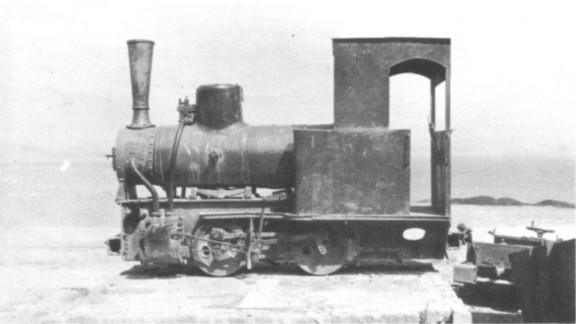
Penlee Quarries 26th August 1964. Unless someone checked the boiler backplate years ago it is doubtful whether the identity of this Koppel well-tank will ever be known; a paragraph in "The Locomotive" (page 163 in the volume for 1909) is singularly unhelpful. And in the salt-laden atmosphere, how much longer will it remain "preserved"? (Author)
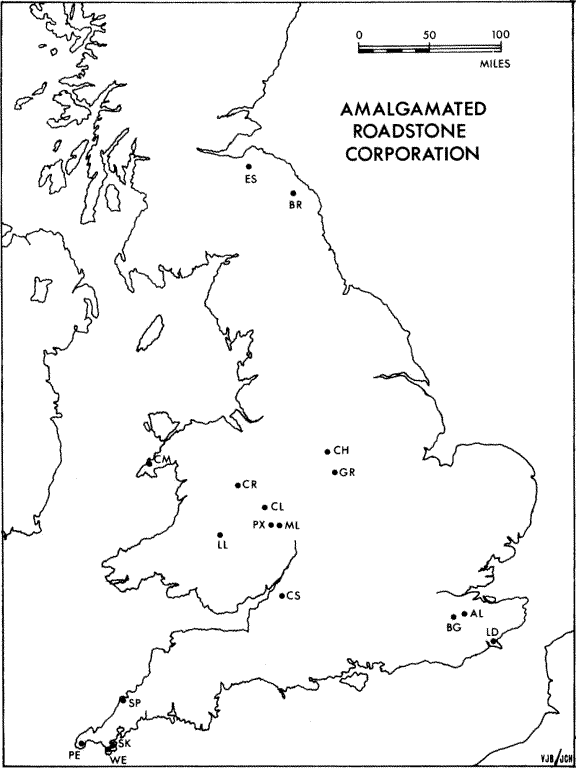
LOCOMOTIVE LIST
| LM 1 PENLEE | 4wD | KS | 4468 | 1930 | New | PE - Wdn 9/61 | (2) |
| LM 2 | 4wD | HE | 2665 | 1942 | (a) | PE - Wdn 6/58 | (2) |
| LM 3 PENLEE | 4wD | HE | 2666 | 1942 | (a) | PE - ML 9/54 - LD 10/54 - PE /58 | |
| LM 4 | 4wD | OK | 10408 | PE - ML 1/53 | Scr /53 | ||
| LM 5 | 4wP | MR | 5094 | 1931 | New | BG - ML - SK - ML /60 | Scr 9/61 |
| LM 6 | 4wD | RH | 183426 | 1937 | New | SK - ML 1/54 | Scr /54 |
| LM 7 | 4wD | RH | 171904 | 1935 | New | SK - ML /60 | Scr /61 |
| LM 8 | 4wP | FH | 1838 | 1933 | New | CM | Scr /49 |
| LM 9 No.5 | 0-4-0ST | HE | 747 | 1901 | New | GR | (1) |
| LM 10 No.2 | 0-4-0ST | HE | 1191 | 1915 | New | GR | Scr c3/63 |
| LM 11 | 4wP | L | RT6572 | 1935 | New | BR - LL /53 | Scr /61 |
| LM 12 | 4wP | L | 7645 | 1936 | New | BR | s/s c/53 |
| LM 13 | 4wTG | S | 7026 | 1926 | New | CR | (3) |
| LM 14 | 4wP | MR | 5037 | 1929 | New | BG - AL | s/s /54 |
| LM 15 | 4wP | MR | 5057 | 1930 | New | BG | (4) |
| LM 16 | 4wD | OK | 5482 | 1934 | New | BG | (4) |
| LM 17 | 4wD | OK | 5483 | 1934 | New | BG | (4) |
| LM 18 | 4wD | OK | 6137 | 1936 | New | BG | (4) |
| LM 19 | 4wD | OK | 6702 | 1936 | New | BG | (4) |
| LM 20 | 4wD | OK | 7375 | 1937 | New | BG | (4) |
| LM 21 | 4wD | OK | 7376 | 1937 | New | BG | (4) |
| LM 22 | 4wP | MR | 5060 | 1930 | New | BG - AL c/53 - BG /53 | s/s /54 |
| LM 23 | 4wD | RH | 172910 | 1934 | New | AL | s/s /54 |
| LM 24 | 4wD | RH | 175412 | 1936 | New | AL - BG 9/54 - ML 10/56 - PE 10/56 | (2) |
| LM 25 | 4wD | RH | 181808 | 1936 | New | AL - BG c/54 | Scr c/54 |
| LM 26 | 4wD | RH | 191642 | 1938 | New | AL - BG c/53 - ML 5/53 - SK /53 | (5) |
| LM 27 | 4wD | RH | 91643 | 1938 | New | AL - BG c/54 - ES 6/54 - ML /57 - SK 11/57 | (5) |
| LM 28 | 4wD | RH | 229655 | 1944 | (b) | AL - LD 2/53 - BG c/54 - PE 9/55 - ML 5/58 | (6) |
| LM 29 | 4wD | RH | 179871 | 1936 | New | AL - BG c/557- LD 2/53 - ML c/57 | (7) |
| LM 30 | 4wD | RH | 229656 | 1944 | (b) | AL - ML /52 - SK /52 - ML c/57 - SK 11/57 - ML c/61 - PE 9/61 | |
| LM 31 | 4wP | MR | 5036 | 1929 | New | BG - ID | Scr /53 |
| LM 32 | 4wD | RH | 183425 | 1937 | New | ID | Scr /54 |
| LM 33 LILIAN | 4wTG | S | 6222 | 1926 | New | CL - (Reb 4wP 3/50) | Scr 1/53 |
| LM 34 TITTERSTONE | 0-4-0T | AE | 1666 | 1913 | New | CL | Scr 1/53 |
| LM 35 | 4wD | OK | 7736 | 1938 | New | WF - BG /49 | (4) |
| LM 36 | 4wD | RH | 183078 | 1937 | New | CH - AL - WF | Scr /54 |
| LM 37 | 4wD | RH | 177643 | 1936 | New | SP - WF - SK /49 - PE | s/s |
| LM 38 | 4wD | FH | 2401 | 1948 | New | CM - PE 7/51 - ML /54 - SK 3/56 PE 9/61 | (9) |
| LM 39 T.W.LEWIS | 4wD | RH | 375316 | 1954 | New | PE | |
| LM 40 J.W.JENKIN | 4wD | RH | 375315 | 1954 | New | PE | |
| LM 41 | 4wD | L | 51509 | 1960 | New | WE | |
| LM 42 No.2 | 4wD | RH | 200748 | 1940 | (c) | ML - PE 7/61 | |
| LM 43 | 0-4-0DH | JF | 4220016 | 1962 | New | GR | (8) |
| LM 44 | 4wD | RH | 246793 | 1947 | (d) | PE | |
| LM 45 | 4wD | RH | 213848 | 1942 | (e) | PE | |
| LM 46 | 4wD | RH | 221592 | 1943 | (f) | PE | |
| LM 47 | 4wD | RH | 287664 | 1951 | (g) | PE | |
| - (NEDDY) | 4wP | L | 30947 | 1948 | New | WE |
(a) ex Tarslag Ltd, Winslow, Bucks, 1/47
(b) supplied to Ministry of Supply order in 1944 but probably new to Allington (AL)
(c) ex M.E.Engineering Ltd, Cricklewood, /61; formerly Doncaster Brick Co, Balby, Doncaster
(d) ex MacSalvors Ltd, Pool, Camborne, Cornwall, 11/62; previously Admiralty, Yard No.AD574
(e) ex MacSalvors Ltd, Pool, Camborne, Cornwall, 11/62; previously Admiralty, Crombie, Fife
(f) ex MacSalvors Ltd, Pool, Camborne, Cornwall, c8/63; previously H. Orchard & Son, scrap merchants, Tregreham Mills, Par, Cornwall, until c7/63; Western Excavating Co Ltd, until 7/63; English Clays Lovering Pochin Co Ltd, Park Works, St Neot, Cornwall, until /57.
(g) ex George Wimpey & Co Ltd, contractors, No.82, 12/64
(1) scrapped on site by Frank Berry Ltd, 10/61
(2) scrapped 3/65; parts sold to Mayer & Newman & Co Ltd, St Erth Station Goods Depot, Cornwall
(3) scrapped on site by James Rollason, Wellington, Salop, 4/62 4) to Robinson, Snodland, Kent, for scrap, /58 5) to George Cohen (Machinery) Ltd, /60
(6) to Bredonvale Products Ltd, Avonside, Defford, Worcs; per Cox & Danks Ltd, 11/59
(7) scrapped on site by Britannia Metals Ltd, 2/58
(8) to E.C.C. (Quarries) Ltd, Croft Granite Quarries, Leics, c12/66 (9 to ? , Redruth, Cornwall, for scrap, /66
| Abbreviations used in this list are:- | |
| D | Diesel locomotive |
| DH | Diesel Hydraulic locomotive |
| P | Petrol locomotive |
| ST | Saddle Tank |
| T | Side Tank |
| TG | Tank loco, geared transmission |
| AE | Avonside Engine Co Ltd, Bristol |
| c | circa - about the date quoted |
| FH | F.C.Hibberd & Co Ltd ("Planet") |
| HE | Hunslet Engine Co Ltd, Leeds |
| JF | John Fowler & Co (Leeds) Ltd |
| KS | Kerr, Stuart & Co Ltd, Stoke-on-Trent |
| L | R.A.Lister & Co Ltd, Dursley, Glos |
| MR | Motor Rail Ltd, Bedford ("Simplex") |
| OK | Orenstein & Koppel A.G., Berlin |
| RH | Ruston & Hornsby Ltd, Lincoln |
| S | Sentinel (Shrewsbury) Ltd, Salop |
| Scr | Scrapped |
| s/s | scrapped or sold; disposal unknown |
BR - Rolmac Ltd, Brada Quarry, Bamburgh, Northumberland
Although probably operating on a small scale at an earlier date, the first official reference to Brads. Quarry is in April 1935 when a new crushing and screening plant was installed. Together with this, a 2ft 0in gauge rail system was built to transport uncrushed stone from the quarry face, and this was operated by two Lister 4−wheel petrol locomotives. The line extended about two hundred yards from the working face to the top of a rope-worked ramp up to the crusher. Locomotive working was abandoned in 1944 and trucks were subsequently moved by hand. According to quarry records, the locomotives were here only until 1948, but at least one is known to have remained until 1953.
CH - Charnwood Granite Co Ltd, Charnwood Granite Quarries, Shepshed, Leics.
These quarries date from about 1850 and a horse-worked line was built at about the same time to convey rock to a processing plant. Steam operation of the 2ft 0in gauge system was introduced at an unknown date, and two locomotives have been recorded - Brush 0−4−2 saddle tank (288 of 1899), and a Bagnall 0−4−0 saddle tank (2071 of 1918) which was owned earlier by the Ministry of Munitions. At this time the quarries were worked by Ellis & Everard Ltd, who also owned granite quarries at Bardon Hill and Markfield. According to present records the Charnwood system was closed in 1932 and this seems to be a likely date as the Bagnall is said to have gone to Bardon Hill in 1936; the Brush had been scrapped or sold at an earlier date. On 26th May 1936 control of the quarries passed from Bardon Hill Quarries (Ellis & Everard) Ltd, as they were then called, to the Charnwood Granite Co Ltd, and in 1937 a Ruston 4−wheel diesel was delivered. It seems probable that this was for use on a new line and not on the old system which had reached a length of ¾ mile not counting the several branches in the quarries. Whether the Ruston did work on such a system is not known, but it was later transferred to Allington Quarry in Kent.
The standard gauge sidings here were shunted by a Baguley 0−4−0 diesel (1699 of 1929) which was sold at an unknown date, shunting subsequently being performed by a road tractor until rail traffic ceased in 1963.
CL - British Quarrying Co Ltd, Clee Hill. Quarries, Titterstone Clee Hill. near Ludlow, Salop
These quarries date from 1858 when a railway was being constructed from Ludlow for the transport of coal. A quarry, opened to produce ballast for the Ludlow & Clee Hill Railway (opened on 24th August 1864), produced such good stone that the industry has flourished there ever since. Three main quarries have operated over the years and in one of these a 3ft 0in gauge rail system was introduced with horse haulage, going over to steam about 1910 when a second-hand loco was obtained. This 0−4−0 saddle tank (Bagnall 1717 of 1903) came to Titterstone Clee from H. Arnold & Sons Ltd, contractors for Embsay Reservoir, Skipton, on which job it was named MARY. It is assumed the loco proved to be superior to the horses, as a few years later a new 0−4−0 side tank was purchased from Avonside (1666 of 1913) and put to work carrying the name TITTERSTONE. This loco was followed by a new Sentinel 4−wheel geared-drive shunter (6222 of 1926) which was named LILIAN.
Wagons were pushed by hand along tracks from the quarry face to a collecting point in the middle of the quarry known as "the turnout", from where they were hauled by locomotive to the crusher. From the crusher a mile long incline, which included a three rail section, ran down the side of the hill to an interchange point at Bitterley on the standard gauge line. Although the rail system was closed in 1952, the quarry remained in use until 1962, the stone being conveyed in road vehicles.
CM - Carreg-y-Llam Quarries Ltd, Llithfaen, Caernarvonshire
These granite quarries are situated on the North Wales coast near Llithfaen and like many others in the area had a rail system which probably dated from before 1900. This was a hand worked line used to convey stone from the face to the crushing plant, whence a cable-worked incline ran down to a quay from where the stone was shipped away. About 1933 a new top face was opened complete with a 2ft 6in gauge line worked by a Planet 4−wheel diesel (Hibberd 1838 of 1933). This loco was replaced by a new one of similar type (2401 of 1948) but a year later the system was dismantled and replaced by lorries and conveyor belts. Sometime in the mid 1950's the pier was abandoned and the output taken away by lorries over a very rough mountain road. The road could not be taken down to the crusher, so the former 2ft 6in gauge incline was relaid with 2ft 0in gauge track, enabling the crushed stone to be taken up again to the level of the quarry face for loading. The quarries were closed in September 1963, the useful plant being removed in 1964. The quarries are now owned by the Penmaenmawr and Welsh Granite Co Ltd, but have not been re−opened.
CR - British Quarrying Co Ltd, Ceiriog Granite Quarries, Criggion, Mont.
These quarries are situated at the end of the old Shropshire & Montgomeryshire Railway's branch from Kinnerley. The original locomotive was a First World War Baldwin 0−4−0 saddle tank (ex ROD 84) but this was replaced by a new Sentinel 4−wheel geared-drive shunter (7026 of 1927). The locomotive was used for shunting wagons at Criggion ready for dispatch on the S&M. However, in the spring of 1940, the bridge over the River Severn between Criggion and Kinnerley was damaged by floods, and so the following procedure was adopted. The Sentinel would take the wagons to the bridge where it would push them across ready for the S&M locomotive to collect, so that neither locomotive actually ventured onto the bridge. In 1943 the bridge was strengthened and, due to the state of the track, the quarry Sentinel took over the working of the whole branch through to Kinnerley. This continued until 1959 when the entire S&M system closed, although traffic had been very light for some years. The Sentinel lasted until 1962, when it was cut up.
There was also a 2ft 0in system in the quarry which was operated by a Bagnall 0−4−0 saddle tank (1650 of 1901) named JACK, obtained from the Cliffe Hill Granite Co Ltd in Leicestershire about 1914. It was superseded by a rope-worked incline in 1921.
CS - John Arnold & Sons, Barn Hill Quarry, Chipping Sodbury, Gloucestershire
Quarrying in the Chipping Sodbury area dates back to Roman times and Arnold's quarry is believed to be on the site of the Roman workings. A short 1ft 8in line was laid in 1928 to carry overburden from the quarry to the waste tip.. It was about eight-hundred yards long and was worked by a 30hp Kerr Stuart 4−wheel diesel (4426 of 1929) obtained on hire-purchase. The line was closed in 1938 and the locomotive stored until transferred to Penlee Quarries in 1947.
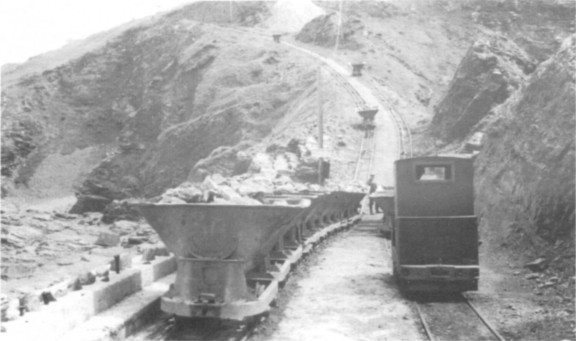
Porthoustock Quarries 17th June 1954. View of the incline with LM 26 (Ruston 191642) on a train of empties. The "up" track on the left conveying full loads had several catch-points. (F.Jux)
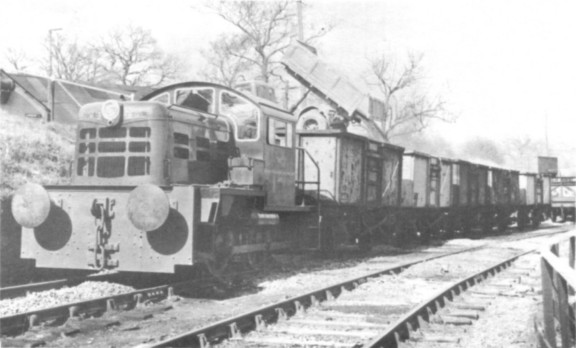
Groby Quarries about 1962. LM 43 (Fowler 4220016) at the loading bank. (John Fowler & Co (Leeds) Ltd)
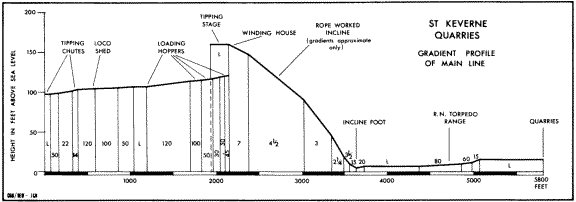
|
|
ES - Amalgamated Limestone Corporation Ltd, East Saltoun, Pencaitland, East Lothian
The only information I have on this quarry comes from A.R.C. records which list a Ruston diesel here from 1954 to 1957. This presumably operated on a 2ft 0in gauge system of some kind, but the quarry is now closed and all other records have been destroyed. Further details would be welcomed.
GR - Groby & Charnwood Granite Co Ltd, Groby Granite Quarries, Leicestershire
Opened in 1832 just to the north of the village, the first quarry at Groby was connected to the Leicester & Swannington Railway by a standard gauge line which, like the L&S, was built without Parliamentary authority. The junction at Glenfield was via a turntable into a loop siding, but in 1865 the Groby Granite Company took control and laid a conventional junction. The present quarries some distance beyond the village are a more recent development, and the line latterly was some two miles long. The original engine shed and wharf were opposite the old quarry, but a shed was later built at the newer quarries. At least ten steam locomotives (mostly Hunslet 0−4−0 saddle tanks) have worked on the line over the years, and these include a Robert Stephenson 0−4−0 tender loco dating from 1833 and an 0−4−0 vertical boiler tank locomotive which was known locally as the "Groby Coffee Pot". The two steam locos which survived until recent years and the diesel which replaced them are included in the locomotive list. In 1966 all rail traffic from Groby ceased when British Railways closed their branch from Desford to Leicester West Bridge, and all production now goes by road.
There was also a 2ft 0in gauge system in the quarries which was of considerable length. The original locomotives were a pair of Hunslet 0−4−0 saddle tanks named JUNIOR (596 of 1893) and SEXTUS (652 of 1896). These were replaced by three Hunslet 0−6−0 saddle tanks named NONUS (992 of 1909), SEXTUS (1021 of 1910) and JUNIOR (1417 of 1921) which were scrapped after the system was abandoned in 1943 in favour of road transport.
LD - British Quarrying Co Ltd, Lydd Beach Shingle Works, Kent
It is not known when these works were opened but a Ruston 4−wheel diesel (183425) was supplied new in 1937. It was used for transporting shingle from the workings to a crushing and washing plant. Dumpers replaced rail haulage in November 1956.
LL - British Quarrying Co Ltd, Llanelwedd Granite Quarries, near Builth Wells, Radnorshire
There were two rail systems here and both probably date from 1929 when the quarries were opened. The first, of 2ft 6in gauge, ran for about half a mile from the main quarry to the crushing plant by the main road; it was horse-worked and closed down in 1953. The other system is a small one of 2ft 0in gauge and runs for about a quarter of a mile from the crushing plant to the stock tips. This has always been hand-worked except between 1953 and 1961 when Lister petrol locomotive LM 11 was tried without a great deal of success.
ML - Amalgamated Roadstone Corporation Ltd, Mobile Plant Repair Depot, Malvern Link, Worcestershire
This, the Corporation's main repair depot, is situated on the premises of their subsidiary company, the Pyx Granite Co Ltd, who had a quarry on the nearby Malvern Hills. Repairs to all kinds of plant are made here and most locomotives received an overhaul here or at Borough Green at some time. There has never been any rail track at Malvern, visits by locomotives being for repairs only.
PE - Penlee Quarries Ltd, Newlyn, Cornwall
The system at Penlee is by far the most active of the remaining ARC railways and has the distinction of being the most westerly railway in England. Quarrying commenced here in the 1890's and about 1900 a 2ft 0in gauge line was laid to connect the quarry with Newlyn Harbour, about half a mile away. To work it a steam locomotive was purchased from A.Koppel of Berlin and this bore the name KOPPEL; Penlee records give the works number as 73, but this is extremely unlikely. KOPPEL, renamed PENLEE about 1916 because of the War, was withdrawn in 1946 and is now preserved at the quarry, although apart from a repaint now and again it is in rather poor condition. Photographs of the loco at work invariably show the driver to be wearing a bowler hat; this gentleman's name was Mr Janner, and he was one of the "old school" of locomen who took great pride in their machines. Not realising that the loco was past repair, he frequently attended to it in the shed after it had been withdrawn. To appease him, the management told him that they were waiting for some spare parts to come from Germany, this story being maintained until Mr Janner died some two years later.
Over the years production has increased until traffic now requires six locomotives - four on the main line and two shunting. Although locomotives by several builders have operated here in the past, the line is now the preserve of a fleet of 4-wheel Ruston diesels. When a ship is in the harbour, traffic is very heavy with a train every five minutes or so. The line, which was originally double track and later singled, has now been doubled again to cope. It starts at a large storage hopper on the coast below the quarry and is single to a secondary loading plant further along the line. One line goes under this and then it is double all the way to the harbour with a loop round a road transfer point which was originally used for passing. A lot of stone carried by the railway is brought in for crushing from a quarry at Castle An Dinas, about four miles to the north of Penzance. From Newlyn harbour the stone is shipped to various distribution points along the south coast and Bristol Channel.
PX - Pyx Granite Co Ltd, Berington Quarry, Malvern Wells, Worcestershire
This quarry on the eastern slopes of the Malvern Hills was opened about 1880, but until about 1908 when it was taken over by the Pyx Granite Company it remained relatively small. A crushing plant was then introduced alongside the main road below the quarry and a rope-worked double track incline about two hundred yards in length was constructed to convey stone down from the quarry. In addition, two narrow-gauge lines on different levels were built from the crushing plant to waste tips on the south side of this plant. These ran for about 150 yards and were hand-worked. In 1929 the Company was bought out by the Malvern Hills Conservators who closed down the quarry immediately in accordance with their policy.
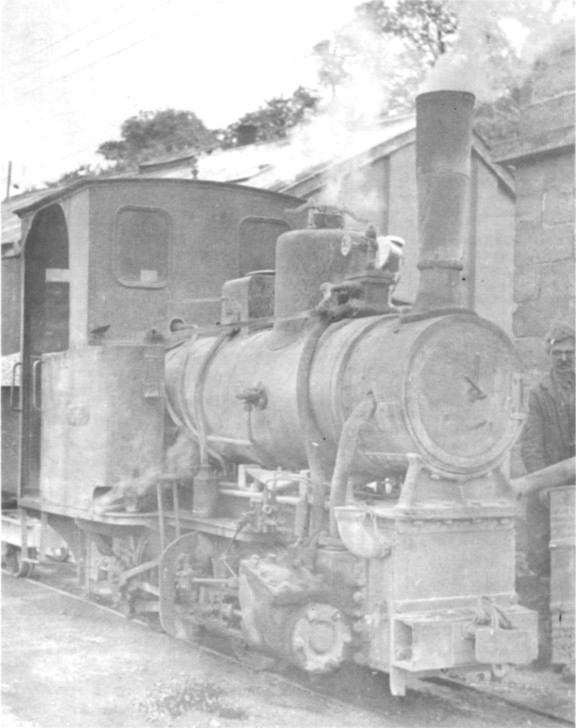
Another view of the Koppel locomotive at Penlee Quarries, showing the original cab and boiler-mounted sandbox. Photograph taken circa 1928 by the late A.H. Lucas and reproduced by courtesy of W.A. Lucas.
SK - St Keverne & Associated Quarries Ltd, Porthoustock, St Keverne, Cornwall
The quarries around Porthoustock date from the late 19th Century but it was not until 1934 that a rail system was introduced. In all there were four separate quarries along the coast although it is not certain whether all were directly served by the railway. The most northerly were at Porthallow and it was here that the rail system started. The quarries were worked by lorries and stone was tipped into wagons from a raised loading point at one end of the quarries. It was then conveyed about a mile along the coast to the processing plant, the line traversing a small cove and a double-track rope-worked incline. At the top and bottom of this incline the wagons were attached to rods which were clamped on to the continuously moving cable. The incline crossed the front of an old quarry but this was almost certainly disused when the railway was built. At the top of the incline the line ran on to the crushing and grading plant into which the stone was tipped. From below the crushing plant a series of short sidings joined to form the second part of the rail system which ran for about a further half mile round the coast to Porthoustock. Here it ran out on to a concrete storage silo, built in the middle. of the bay, from which ships were loaded. The line also served a stock tip in an old quarry, the stocks being removed by road as required; and also a road loading point some two hundred yards beyond. From the middle level of the crushing and grading plant a short line ran out into another old quarry, parallel to the main line but not connected, and this was worked by a 4−wheel Lister petrol locomotive (30202 of 1946). The stockpile formed by this line was also worked away by road.
Production ceased towards the end of 1958, although only part of the rail system had been in use for some months previously; the railway was partially removed soon afterwards. The remainder still exists, almost buried by lorries removing stone from the stockpile by the crusher.
SP - Cornish Road-Metal Ltd, Stepper Point Quarry, Padstow, Cornwall
This quarry was situated in a very inaccessible place on the most northerly part of Stepper Point peninsula to the north-west of Padstow. It was probably opened just after the First World War, as the original locomotive was a former War Department "Simplex" 4−wheel petrol (Motor Rail 1036) built in 1918. From the quarry the stone was taken round the Point to the east side where the crusher was situated. After crushing it was taken a short distance to the jetty which was built out into the sea off the rocks. All production went away by sea, there being no road into the quarry.
Although the quarry was closed about 1948, most of the equipment is still intact. Only the track and the working locomotive were removed and the frame of Motor Rail 4029 was still lying amidst the ruins of the crusher in 1967. The rail system was probably used to move most of the stone but, as everything is now overgrown, it is difficult to trace its extent.
WE - West of England Road-Metal Co Ltd, Rosenython Quarries, Porthoustock, St Keverne, Cornwall
About forty yards in length, the system here is used for transferring stone from the hoppers beneath the crusher to the top of the storage bins. The track is laid in the form of a cross with two lines from under the crusher running straight on to the storage bins and another line crossing these at right-angles and serving two other storage hoppers. The hoppers supply either road vehicles or ships, which can anchor alongside them. The system was originally operated by NEDDY, a 4−wheel petrol locomotive (Lister 30947) supplied new in 1948. When the St Keverne quarries across the bay closed in 1958, the Lister there (30202 of 1946) was transferred here and used to help rebuild NEDDY in 1960. The latter has never received an official number in the LM series but is included at the end of the locomotive list as it is still in use.
WF - St Keverne & Associated Quarries Ltd, Winford, near Bristol, Somerset
This quarry, about six miles south-south-west of Bristol, was opened in 1938 after permission had been obtained to build a crushing plant and other buildings alongside a minor road about a mile south of Winford village. The quarry was about three hundred yards to the north-east and a 2ft 0in gauge rail system was installed to transport the uncrushed granite from the quarry. Starting at a loading point on the east side of the quarry, the railway ran across the quarry floor through a small rock cutting and then crossed a field on a low embankment to terminate at a tipping dock by the crushing plant. There was also a short branch on to a waste tip near the quarry. The quarry was quite a small one and closed down in 1954.